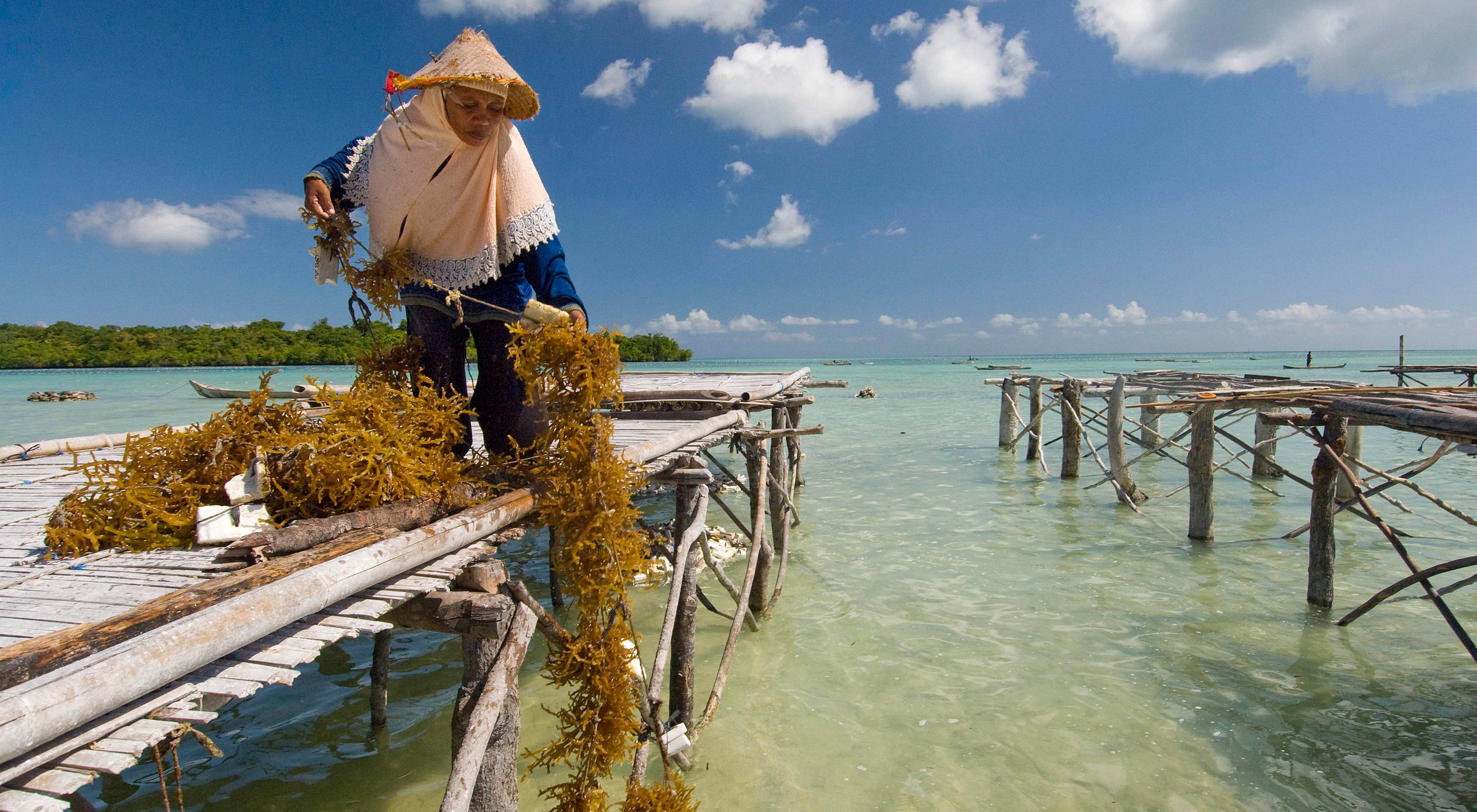New Markets Could Catalyze Seaweed’s Regenerative Potential on Land and Sea
Report Published by The Nature Conservancy and Bain & Company Identifies Path Forward to Drive Growth and Decarbonize Supply Chains
Media Contacts
-
Ann Kaiser
Senior Media Manager
Email: ann.kaiser@tnc.org
With the need for climate solutions more urgent than ever, seaweed aquaculture has emerged as a potential mechanism to both sequester carbon as well as provide lower-impact substitutes for carbon-intensive products. Though carbon crediting likely doesn’t offer farmers adequate economic incentives to support growth of this industry and scale its climate benefits at this time, new markets for seaweed like biostimulants and bioplastics hold significant promise, according to a new report published today by The Nature Conservancy and Bain & Company.
“Enthusiasm for seaweed aquaculture is warranted, given its many environmental benefits,” said Robert Jones, TNC’s Global Aquaculture Lead. “Not only does it require no freshwater, land, or fertilizers to grow, but it can restore ocean health by removing excess nitrogen from coastal waterways, offsetting the localized effects of ocean acidification, and providing habitat for a variety of marine species. As the sector grows, it’s important we rigorously evaluate both the opportunities and limitations of seaweed farming so we can ensure investments are well placed and have the best chance of generating positive outcomes for communities and ecosystems.”
There is evidence that farmed seaweed can sequester small amounts of carbon, which has driven interest in carbon financing to support farmers’ livelihoods and encourage the implementation of practices that provide climate benefits. Eligibility for such programs is generally dependent on additionality, meaning that the practices wouldn’t have occurred without the support of the carbon credits. Furthermore, uncertainty about the amount and permanence of carbon sequestered – of which there is a great deal in seaweed aquaculture – typically reduces the number of carbon credits received. Factoring in additionality and discounts, current blue carbon prices of about $30 per ton would not be enough to incentivize climate-smart farming practices; for a carbon financing program to financially motivate behavior change, the report estimates that that credit prices would need to be about 10 to 15 times higher, research would need to show much higher sequestration levels, or the industry would need to develop practices that dramatically increase carbon sequestration.
While carbon crediting is unlikely to drive meaningful growth in the near-term, positioning seaweed as a low-carbon alternative to higher-emissions products could deliver both economic and environmental benefits. One market primed for growth is biostimulants, which are materials that improve terrestrial crop yields and health, nutrient uptake, stress tolerance, and soil quality. A $1 billion industry, the seaweed biostimulant market currently requires between 250,000 to 500,000 tons of seaweed per year, most of which is wild harvested. Already poised for 13% annual growth, there is even more room for development; if seaweed biostimulants were applied to just 3% of global farmland, it would boost demand to 3 million tons. Supporting this kind of growth with farmed seaweed would not only bolster the industry but also allow for the preservation of wild species and their ecological benefits.
Similarly, seaweed bioplastics are poised to grow market demand and serve as a replacement for less sustainable products. Unlike traditional plastics, which are derived from petroleum and don’t decompose, bioplastics are derived from renewable resources and are often biodegradable. But not all bioplastics are created equal; some are sourced from materials that require large amounts of inputs – including land, freshwater, and fertilizer – to grow, while seaweed does not. That being said, in both the bioplastics and biostimulant markets, seaweed is significantly cost disadvantaged compared to traditional products and competing green alternatives; there is a need to either justify a higher price by differentiating seaweed as a premium product or lower the price through greater efficiencies, improved processing technology, or subsidies.
The results of this report will inform TNC’s restorative seaweed initiative and provide guidance for seaweed farmers, research partners, governments, and other NGOs. “All stakeholders have a role to play in building a better seaweed industry,” said Tiffany Waters, TNC’s Global Aquaculture Manager. “With this new information, we will be better equipped to realize seaweed aquaculture’s potential to regenerate marine ecosystems and decarbonize supply chains.”
The Nature Conservancy is a global conservation organization dedicated to conserving the lands and waters on which all life depends. Guided by science, we create innovative, on-the-ground solutions to our world’s toughest challenges so that nature and people can thrive together. We are tackling climate change, conserving lands, waters and oceans at an unprecedented scale, providing food and water sustainably and helping make cities more sustainable. The Nature Conservancy is working to make a lasting difference around the world in 81 countries and territories (40 by direct conservation impact and 41 through partners) through a collaborative approach that engages local communities, governments, the private sector, and other partners. To learn more, visit nature.org or follow @nature_press on X.
